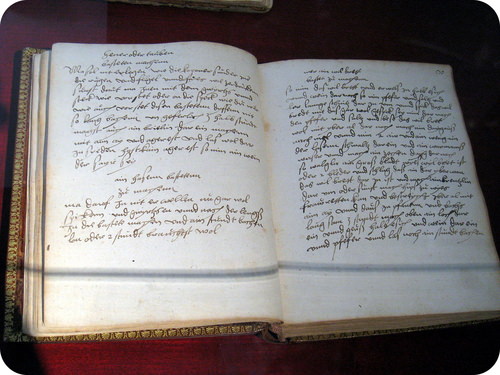11.1 单等数
章节大纲
-
What’s for dinner?
::晚餐吃什么?Various ways of recording recipes have developed over the centuries. The cookbook shown above was written by a woman who probably collected all her own recipes. Later, printed cookbooks became available (even guys had no excuse for not being able to cook). Today we can find recipes on a number of internet sites and can quickly search for information on how to cook anything we want. Reading a recipe sometimes requires we understand a few codes and symbols (what’s the difference between a tsp and a Tsp?), but the information on what we start with and what we end up with is there.
::几个世纪以来,记录食谱的各种方式都有所发展。 上面所展示的烹饪手册是由一位可能收集了她所有食谱的妇女撰写的。 后来,印刷烹饪手册被提供(即使男人也没有借口不能烹饪 ) 。 今天,我们可以在一些互联网网站上找到食谱,并快速寻找如何烹饪我们所想要的东西的信息。 阅读食谱有时需要我们理解一些代码和符号(tsp和tsp之间有什么区别 ? ) , 但是关于我们从什么开始和我们最终要做什么的信息是存在的。Writing Chemical Equations
::化学等式are occurring all around you. Plants use sunlight to drive their photosynthetic process and produce energy . Cars and other vehicles burn gasoline in order to power their engines. use electrochemical reactions to produce energy and power many everyday devices. Many chemical reactions are going on inside you as well, especially during the digestion of food.
::植物利用阳光推动光合工艺和生产能源。汽车和其他车辆燃烧汽油,为引擎提供动力。使用电化学反应来产生能量和发电。许多日常装置也在你体内发生许多化学反应,特别是在食物消化过程中。In math class, you have written and solved many mathematical equations. Chemists keep track of chemical reactions by writing equations as well. In any chemical reaction one or more substances , called reactants , are converted into one or more new substances, called products . The general form of the equation for such a process looks like this.
::在数学类中,您已经写了并解答了许多数学方程式。 化学家也通过写方程式来跟踪化学反应。 在任何化学反应中,一种或多种物质,即所谓的反应物质,被转换成一种或多种新物质,即所谓的产品。这种过程的方程式的一般形式是这样的。
::活性剂Unlike in a math equation, a chemical equation does not use an equal sign. Instead the arrow is called a yield sign and so the equation is described as “reactants yield products”.
::与数学等式不同的是,化学等式不使用等号,而将箭头称为产量符号,因此,该等式称为“反应剂产物”。Word Equations
::单等数You can describe a chemical reaction by writing a word equation . When silver metal is exposed to sulfur it reacts to form silver sulfide. Silver sulfide is commonly known as tarnish and turns the surface of silver objects dark and streaky black (see Figure ). The sulfur that contributes to tarnish can come from traces of sulfur in the air or from food such as eggs. The word equation for the process is:
::您可以用文字方程式描述化学反应。 当银金属暴露在硫化物中时, 它会反应成银硫化物。 银硫化物通常被称为污点, 并会把银物体的表面变黑(见图 ) 。 造成污点的硫化物可以来自空气中硫化物的痕迹, 或者来自蛋类等食物。 这个过程的单词方程式是:
::银+硫磺The silver and the sulfur are the reactants in the equation, while the silver sulfide is the product.
::银和硫是方程中的反应物,而银硫化物是产品。You can see dark spots of tarnish (silver sulfide) forming on this ring as it reacts with sulfur compounds in the air. Another common chemical reaction is the burning of methane . Methane is the major component of natural gas and is commonly burned on a gas stove or in a Bunsen burner (see Figure ). Burning is a chemical reaction in which some type of fuel is reacted with oxygen gas. The products of the reaction in the burning of methane as well as other fuels are carbon dioxide and water. The word equation for this reaction is:
::另一个常见的化学反应是甲烷的燃烧。甲烷是天然气的主要成分,通常在燃气炉或本森燃烧炉中燃烧(见图 )。燃烧是一种化学反应,其中某种燃料与氧气发生反应。甲烷和其他燃料燃烧过程中的反应产品是二氧化碳和水。
::甲烷+氧-二氧化碳+水A Bunsen burner is commonly used to heat substances in a chemistry lab. Methane is reacted with oxygen to form carbon dioxide and water. Word equations can be very useful, but do have one major drawback. They cannot be used for any quantitative work. A word equation does not tell how many moles of each material are needed or how many moles of product are formed.
::单词方程式可能非常有用, 但确实有一个重大缺陷 。 它们不能用于任何定量工作 。 单词方程式不能说明每种材料需要多少摩尔或产品中有多少摩尔。Summary
::摘要-
Word equations are used to describe the conversion of reactants to products.
::文字方程式用来描述反应器转换成产品的情况。
Review
::回顾-
Write the generic form of a chemical reaction.
::写作化学反应的通用形式 。 -
What are reactants?
::什么是复生者? -
What are products?
::什么是产品?
-
Word equations are used to describe the conversion of reactants to products.


